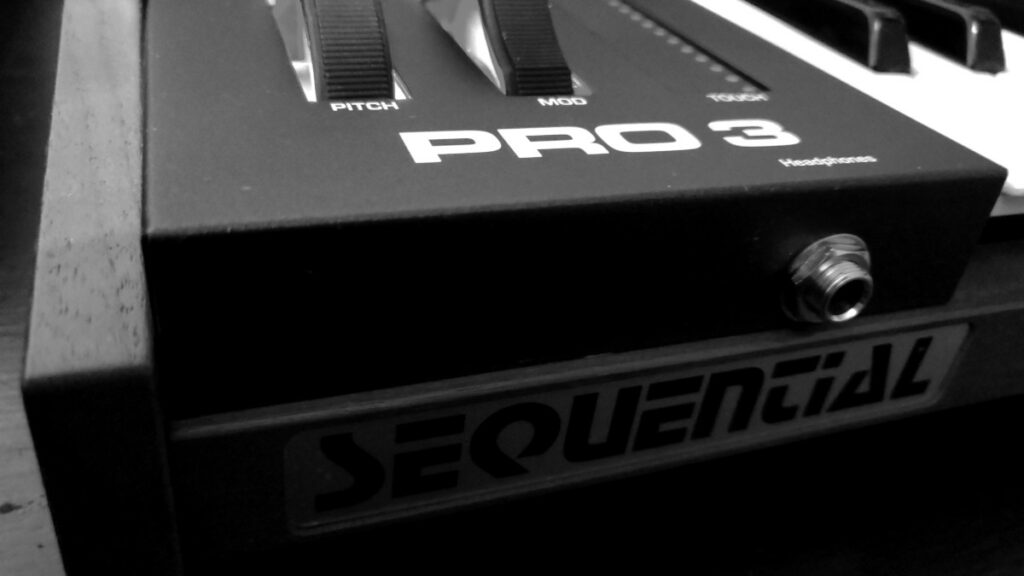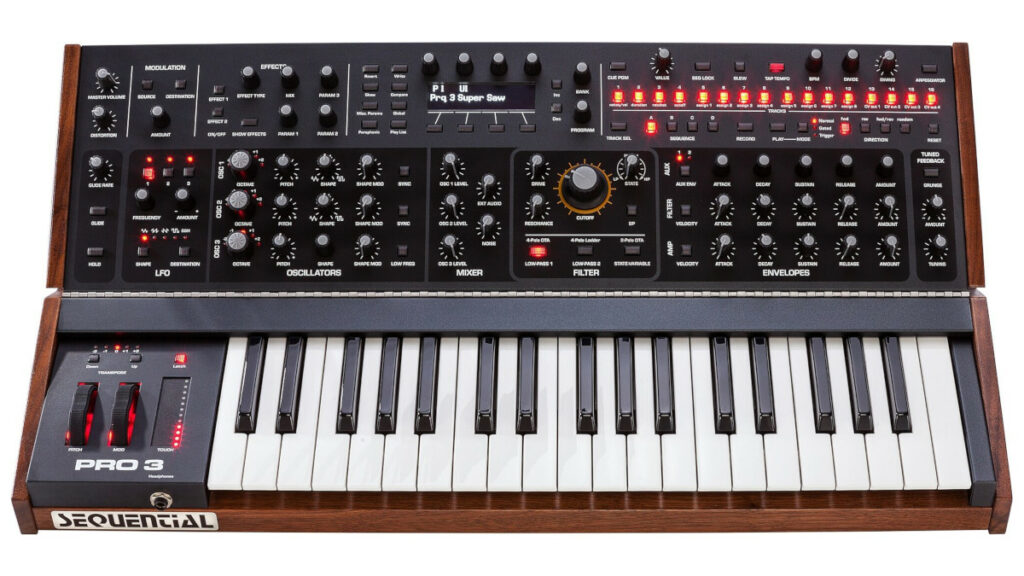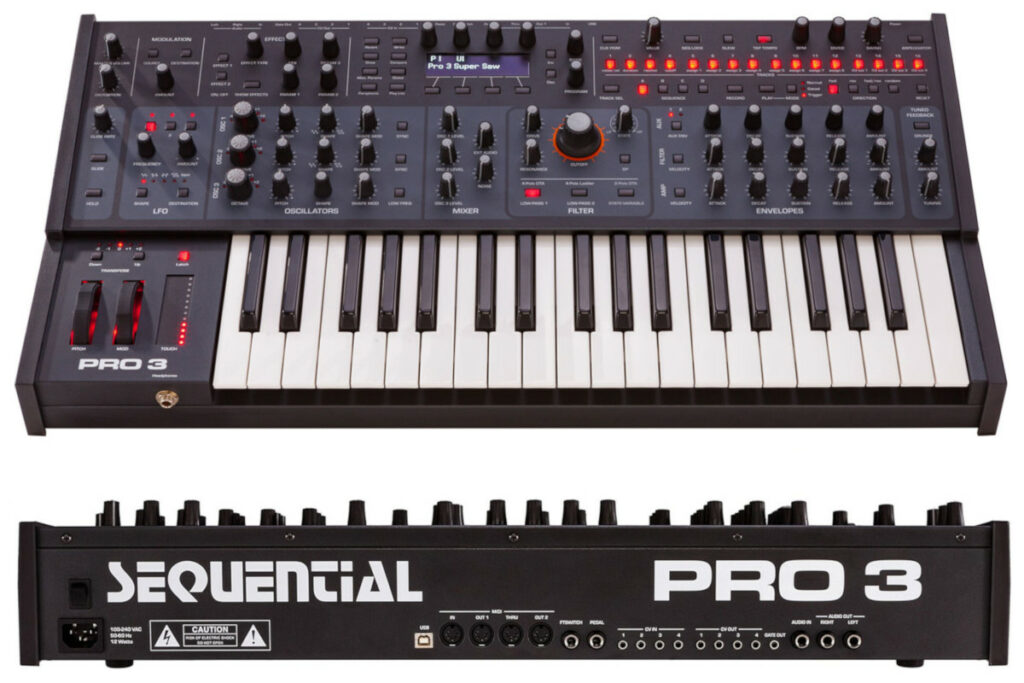
Note: This page is no longer updated as of April 2023. Though the Sequential Pro 3 is amazing and I highly recommend it, I no longer own one and will not be blogging about it.
Clearly the Sequential Pro 3 is the #1 monophonic paraphonic synth on the market today
Sequential Pro 3 $1999.00 Standard Edition – $2199.00 Special Edition
I can’t speak for the market, but an informed synthesist knows there is nothing quite like a Sequential Pro 2; it clobbers every other keyboard class monophonic/paraphonic synth made. A Pro 3 would have to be an amazing machine to take its place. It is a very high bar to reach that has been set by the Pro 2. The Pro 3 reaches that bar.
First of all, both Pro 3 models look great, especially the SE with its ala Moog hinge, traditional woods and printed panel design that matches the Sequential Prophet X. The Pro 3 includes both analog and digital wavetable oscillators. The sequencer is killer. The 4 knob/4 button screen interface is a familiar joy.
I’m sure the high end paraphonic synthesizer market is a tough place to play, but after the initial sparkles wore off, I saw a few major changes in the Pro 3 compared to the Pro 2. It is very important to approach the Pro 3 as a whole new synth. It is not a souped up Pro 2.
The Pro 3 has 37 keys exactly like the Moog Subsequent 37. This is the critical competitor comparison here in my opinion. Sequential/Dave Smith Instruments synths have always been Moog killers. In fact, when I decided to buy the Pro 3, it was mainly to replace my Subsequent 37. I loved the Moog, but I’m an even bigger fan of the Sequential screen/knob workflow (and let’s face it, the Subsequent 37’s screen capabilities at best are extremely dated), and now with Pro 3’s analog and digital wavetable oscillators, the Moog would have been even further isolated in my gear, so I sold it.
My Pro 3 use is generally lead, bass, percussion, heavily sequenced or modulated sounds. It is not my go to poly. I have 2 flagship polyphonics; I am not looking for the Pro 3 to do chords or pads, though it can do that very well. Paraphonic is the most I need and most of the time mono. Dave Smith did his homework here, the market yearned for analog and wavetable oscillators and the price is still in a range it doesn’t have to compete with high-end polys.
With all 3 oscillators, the Pro 3 has 3 paraphonic voices instead of the Moog Subsequent 37’s 2 paraphonic voices. To be clear though, you can only do 2 of those voices with the exact same oscillators (analog). I think many people will really like the Pro 3’s analog oscillators. They sound amazing. You can stick to the classic wave shapes (triangle, saw and pulse, all with wave shaping) common to all 3 oscillators (analog and digital) to get fairly similar paraphonic voices. A 2 oscillator duo mode is also in firmware 1.1 and newer.
Some might consider 3 voices with 2 distinct types of oscillators to be somewhat unusual, however I think the unusual would be very desirable and exactly what you want. Mixing it up even further with all 3 oscillators set to different waveforms, shaping and modulation is the peak use of the paraphonic mode in my opinion.
The 3rd digital oscillator is quite interesting, with 64 digital wavetable slots with 16 waves in each slot with wave morphing; can function as an LFO for complex wavetable-based modulation. Wavetable slots 1-32 are factory supplied wavetables. Wavetable slots 33-64 are for user supplied wavetables as of the 1.1 firmware update. There is also a Sequential wavetable generator site to make an unlimited selection of wavetables for those user supplied slots.
Obviously, the Pro 3 is no Waldorf Quantum, but I’m 100% certain that is not Sequential’s intention nor are the price points remotely comparable.
There are 3 filters on the Pro 3. You can use them one at a time. There is no serial, parallel, or split oscillator routing. Dave Smith says it would get messy routing 3 filters, and most of the time routing a low-pass through a low pass wouldn’t make sense. Personally, I would have liked to have split oscillator routing through two different filters, but this is minor.
There is 1 latchable position-sensitive touch slider, without pressure-sensitivity. There are 3 LFOs, and to be exact, the wavetable oscillator can be your 4th LFO, and its abilities are a real upgrade to the LFO palette.
The Pro 3 improves on the Pro 2 capabilities to function as your control center synth. In addition to MIDI in, MIDI out 1, MIDI thru and MIDI out 2, it has 4 CV inputs, 4 CV outputs and a gate output. The 16 track 64 step sequencer outputs to CV and all other modulation destinations. All the extensive modulation sources output to CV as well.
The Pro 3 is a real contender, I expect it to outsell the Pro 2. The Pro 3 is definitely a Moog Subsequent killer. You will find many people that have owned both, and almost every one of them prefer the Pro 3 over the Moog. A small minority still hold on to the legend of Moog bass, and perhaps it’s subjective but I think they are meshuganah. The Pro 3’s bass will peel the posters off your walls, if you let it.
In actual use, the Pro 3 pairs well with a Prophet X or Quantum, just like the Pro 2 already does.
If you are fortunate enough to have a Sequential Pro 2, keep it! The Pro 3 not only reaches the bar the Pro 2 sets, but complements it in amazing ways.
“Combining a Sequential Pro 2 and Pro 3 creates a monster synth system… 7 oscillators, 5 filters, 7 envelopes, 32 lanes of note, parameter and CV sequencing, 8 assignable CV Ins, 8 assignable CV Outs, and I’m not even going to try to count the modulation possibilities.” -Chris Stack
I know I’m not the only one that thinks the Pro 3 really whets the appetite for a Sequential Pro Poly8. One can only hope. Sequential Pro 2/3 features are like nothing else.
Thanks!
-Yehuda



Manufacturer’s website
https://www.sequential.com
Product support, downloads
https://www.sequential.com/support
Strongly recommended that you download the newest OS, unless you hate bug fixes, stability and new features.
Facebook user groups
Sequential Pro 3 Synth
https://www.facebook.com/groups/762398134270622
Sequential/DSI Pro 2/3 Users Group
https://www.facebook.com/groups/719776201445367
Forums
Sequential Forums
https://forum.sequential.com
Videos
Yehuda Rothschild Sequential Pro 3 YouTube Playlist
Useful Links
Follow on Mastodon – TurtleIsland.social/@Yehuda
This page is subject to content updates/additions. If you think any content should be updated or added, please leave a private comment on Mastodon – TurtleIsland.social/@Yehuda.
Specifications
3 OSCILLATORS
- Two analog, voltage-controlled oscillators
- One DSP-based digital oscillator
- Analog oscillators produce three classic wave shapes: (triangle, saw, pulse) with variable shape modulation/pulse width on each
- Digital oscillator produce 64 digital wavetables of 16 waves each with wave morphing, plus classic wave shapes (sine, triangle, saw, variable-width pulse) and super saw
- Digital oscillator 3 can function as an LFO for complex wavetable-based modulation
- White noise generator
- Hard sync, per-oscillator Glide, Oscillator Slop
3-VOICE PARAPHONIC PLAYABILITY
- 3-voice paraphonic mode with individually-gated envelopes per oscillator
3 FILTERS
- Three classic filter types
- Filter 1 is a 4-pole, 24 dB per-octave, Prophet-6™ low-pass filter
- Filter 2 is a classic, 4-pole, 24 dB per-octave, transistor ladder filter with optional resonance compensation
- Filter 3 is a 2-pole, 12 db per-octave, OB-6™ state-variable filter. It can be continuously varied between low-pass, notch, and high-pass operation, with an optional band-pass mode.
3 LFOS
- Three syncable LFOs with phase offset and slew per LFO
- Five waveshapes: triangle, saw, reverse saw, square, and S&H
4 ENVELOPES
- Four ADSR envelopes with delay (Filter, VCA, and two Auxiliary envelopes)
- Envelopes freely assignable to multiple modulation destinations
- All envelopes can repeat/loop
DIGITAL EFFECTS
- Dual digital effects
- Stereo delay, BBD delay, chorus, flanger, phaser, ring mod, vintage rotating speaker, distortion, high-pass filter, super plate reverb
FEEDBACK AND DISTORTION
- Tuned feedback with Grunge for extra-aggressive tonal destruction
- Programmable analog distortion
32-SLOT MODULATION MATRIX
- 32 slot modulation matrix with over 46 mod sources and over 171 mod destinations
- Modulation assignment buttons enable quick and easy modulation routing
- Mod Matrix runs at audio rates
4 CONTROL VOLTAGE INS & OUTS AND GATE OUT
- Four control voltage (CV) inputs and outputs for interfacing with modular synths and other CV-compatible devices
- Parameters that can be sent to CV outputs include oscillators, LFOs, envelopes, sequencer tracks and any other source within the modulation matrix. Runs at audio rates.
- Gate Out for triggering external CV-compatible devices. Any CV in can be used as a gate input.
16-TRACK SEQUENCER
- Advanced sequencer with three modes: normal, gated, and trigger
- 16 tracks and 4 linkable 16-step phrases
- Per-step ratcheting, duration, and velocity
- Multiple playback modes: forward, reverse, forward/reverse, random
- Supports real-time/step input, rests, and variable-length sequences
- Syncs to MIDI clock and external audio and CV input
- Sequences freely assignable to any modulation destination
ARPEGGIATOR
- Sophisticated arpeggiator with up, down, up+down, random, assign modes
- Syncs to MIDI clock and external audio and CV inputs
- Re-latching arpeggiation
- Runs concurrent with Sequencer for arpeggiated patterns with parameter automation
CONTROLS
- Over 60 knobs and 70 buttons enable deep, comprehensive editing with minimal menu diving
- Backlit pitch and mod wheels are easily visible in low-light situations and have a smooth, precise response.
- Independently adjustable upper and lower pitch wheel range
- Position-sensitive latchable touch slider for enhanced interactivity and control
- Full-sized, three-octave, semi-weighted keyboard with velocity and aftertouch
MEMORY
- 512 user and 512 factory programs
- Playlist mode for generating easily accessible set lists of your favorite programs
IN/OUT
- 1 MIDI In, 1 MIDI Out, and 1 MIDI Thru/Out 2 port
- USB port for bidirectional MIDI communication
- 4 CV inputs (4 x 1/8″ jack) with -10v to +10v voltage range
- 4 CV outputs (4 x 1/8″ jack) with -10v to +10v voltage range
- 1 Gate Out (1/8″ jack)
- 1 Sustain/footswitch input
- 1 Expression pedal input
- 1 External audio input (1/4″ phone jack)
- Main stereo output (2 x 1/4″ phone jack)
- Headphone out (stereo 1/4″ phone jack)
POWER
- 1 universal IEC AC power inlet for internal power supply
- Operates worldwide on voltages between 100-240v, 50-60Hz, 30 watts maximum power consumption
PHYSICAL SPECS
- Premium, 3-octave, semi-weighted Fatar keyboard
- 26.5″ L x 13″ W x 3.5″ H (67.3 cm x 33 cm x 8.9 cm)
- Weight: 16 lbs (7.25 kg)